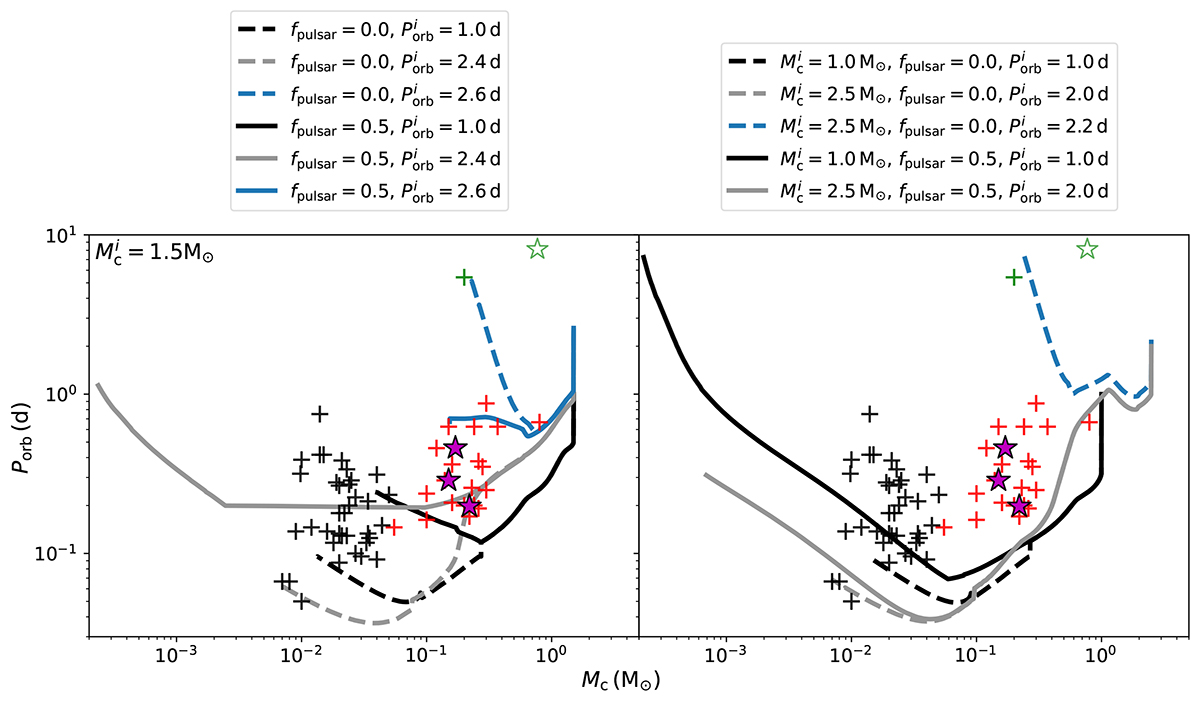Fig. 6.

Download original image
Orbital period evolution versus companion mass of selected binaries from our simulated grid shown in Figure 1. The term Mc is the mass of the companion to the NS, and Porb is the orbital period. The figure shows the effect of pulsar wind irradiation, comparing fpulsar = 0.0 (dashed lines) and 0.5 (solid lines). The left panel shows the tracks with ![]() ,
, ![]() , 2.4, and 2.6 d. The right panel shows two initial companion masses,
, 2.4, and 2.6 d. The right panel shows two initial companion masses, ![]() (with
(with ![]() d) and 2.5 M⊙ (
d) and 2.5 M⊙ (![]() and 2.2 d). We compared our tracks to Mc, min and Porb for BWs (faint black crosses), RBs (faint red crosses), and huntsmen spiders (faint green crosses), from Nedreaas (2024, and references therein). The green star is the huntsman candidate 2FGL J0846.0+2820, observed by Fermi-LAT (Swihart et al. 2017). The magenta stars show the three transitional MSPs (tMSPs) observed, PSR J1023+0038 (Mc = 0.22 M⊙ and Porb = 4.75 h; Shahbaz et al. 2019; Thorstensen & Armstrong 2005), IGR J18245–2452 (Mc, min = 0.17 M⊙ and Porb = 11.03 h; Papitto et al. 2013), and XSS J12270–4859 (Mc, min = 0.15 M⊙ and Porb = 6.91 h; Roy et al. 2015; de Martino et al. 2015; Bassa et al. 2014).
and 2.2 d). We compared our tracks to Mc, min and Porb for BWs (faint black crosses), RBs (faint red crosses), and huntsmen spiders (faint green crosses), from Nedreaas (2024, and references therein). The green star is the huntsman candidate 2FGL J0846.0+2820, observed by Fermi-LAT (Swihart et al. 2017). The magenta stars show the three transitional MSPs (tMSPs) observed, PSR J1023+0038 (Mc = 0.22 M⊙ and Porb = 4.75 h; Shahbaz et al. 2019; Thorstensen & Armstrong 2005), IGR J18245–2452 (Mc, min = 0.17 M⊙ and Porb = 11.03 h; Papitto et al. 2013), and XSS J12270–4859 (Mc, min = 0.15 M⊙ and Porb = 6.91 h; Roy et al. 2015; de Martino et al. 2015; Bassa et al. 2014).
Current usage metrics show cumulative count of Article Views (full-text article views including HTML views, PDF and ePub downloads, according to the available data) and Abstracts Views on Vision4Press platform.
Data correspond to usage on the plateform after 2015. The current usage metrics is available 48-96 hours after online publication and is updated daily on week days.
Initial download of the metrics may take a while.


